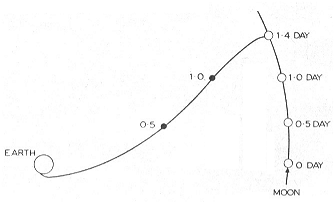The E-4 ProjectExploding a Nuclear Bomb on the MoonPublished in Russian at his Web-site and published here in English by Mr Zheleznyakov's kind permission. (Translated into Swedish by Mrs Caroline Birger and then into English by Sven Grahn.) There are corrections to Mr Zheleznyakov's text made below by Sven Grahn in the form of strikethroughs and words added within brackets. These correction are the result of a letter to the editor of JBIS, April 1999, clearing up the E-sewries designations. A summary of this letter can be found in the article "Object E - the early Soviet lunar probes".
The formulation of Soviet plans for conquering the Moon started with a letter that Sergei Pavlovich Korolev and Mstislav Vsyevolodovich Keldysh sent on 28 January 1958 to the Central Committee of the Communist Party of the Soviet Union. In this letter two main points for the lunar programme were spelled out: lunar impact and a flight around the moon to image its far side. This programme was approved by first party secretary N.S. Chrustjev, who took interest in the political aspect of space exploration, and its implementation could be initiated.
The first proposal for the programme came from Keldysh
and formed the basis for further work. The first project received the designation
E-1 and had the purpose of hitting the moon, the second [and third projects]
were called E-2 [and E-3] and entailed a lunar "fly-around" to take pictures
of the far side, and the Like all the other projects the lunar surface nuclear explosion proposal came from the circle of Academicians. Its originator was the famous Soviet nuclear physicist Jakov Borisovich Seldovich. The primary aim of the project was to prove to the whole world that a Soviet spacecraft had really reached the surface of the Moon. Seldovich had the following in mid: The spacecraft would in itself be quite small and its flight to the moon would not be possible to observe for any astronomer on earth. Even if filled with conventional explosives, its drop on to the lunar surface would not be possible to observe from Earth. But, if a nuclear device was exploded on the Moon's surface, the whole world would be able to observe the event and nobody would be able to pose the question: has a Soviet spacecraft really reached the Moon? It was assumed that a nuclear explosion on the Moon would be accompanied by such a light flash that it would easily be observable by all observatories on Earth. Despite the number of opponents to such a project it was studied, like the other proposals, in detail. OKB-1 (S.P Korolev) even manufactured a mock-up of the spacecraft. Its dimensions and mass were determined by nuclear physicists basing their work on the rather inefficient nuclear weapons designs of that time. The container with the nuclear charge was to equipped with initiator rods in every direction, be like an anti-shipping mine, to ensure an explosion at the moment of contact with the Moon's surface. Fortunately the project never advanced beyond the stage of a mock-up. Already at the initial stage of the project the safety issues associated with such flight were raised. Nobody could provide a 100 percent guarantee that the charge would be safely delivered to the Moon. If the carrier rocket would fail during the operation of the first or second stage the container with the nuclear charge would fall on the territory of the Soviet Union. In case the third stage would fail, the charge could possibly fall on the territory of other countries causing a highly undesirable international incident. Also, the charge could end up in Earth orbit from which it would fall at a time and lace that nobody could predict. To miss the Moon and to send the charge on an infinite journey around the Sun was also an unpleasant thought. There was also an organisational-political problem.
In order for the explosion to be observed by foreign observatories these
had to be notified in advance. The method of doing so nobody could find.
Finally it was decided to drop the |
